What is 'Islamic State'?
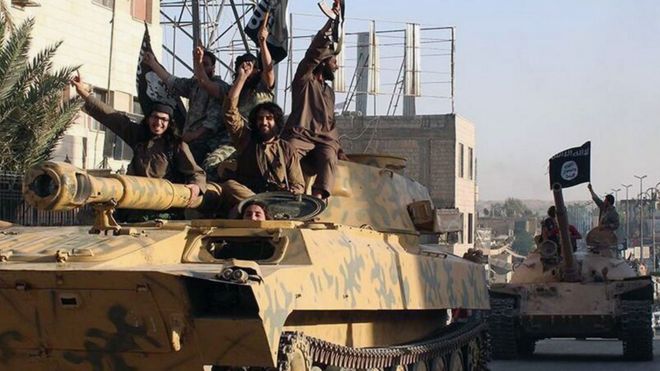 AP
AP
The jihadist group Islamic State (IS) burst on to the international scene in 2014 when it seized large swathes of territory in Syria and Iraq. It has become notorious for its brutality, including mass killings, abductions and beheadings. The group though has attracted support elsewhere in the Muslim world - and a US-led coalition has vowed to destroy it.

What does IS want?
In June 2014, the group formally declared the establishment of a "caliphate" - a state governed in accordance with Islamic law, or Sharia, by God's deputy on Earth, or caliph.
It has demanded that Muslims across the world swear allegiance to its leader - Ibrahim Awad Ibrahim al-Badri al-Samarrai, better known as Abu Bakr al-Baghdadi - and migrate to territory under its control.
IS has also told other jihadist groups worldwide that they must accept its supreme authority. Many already have, among them several offshoots of the rival al-Qaeda network.
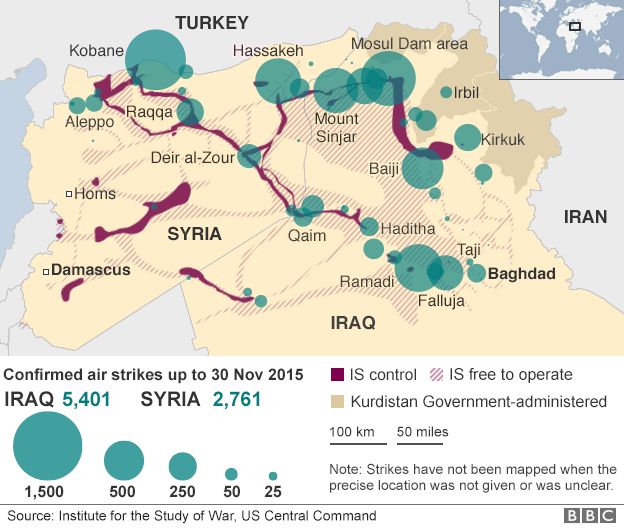
IS seeks to eradicate obstacles to restoring God's rule on Earth and to defend the Muslim community, or umma, against infidels and apostates.
The group has welcomed the prospect of direct confrontation with the US-led coalition, viewing it as a harbinger of an end-of-times showdown between Muslims and their enemies described in Islamic apocalyptic prophecies.

What are its origins?
IS can trace its roots back to the late Abu Musab al-Zarqawi, a Jordanian. In 2004, a year after the US-led invasion of Iraq, Zarqawi pledged allegiance to Osama Bin Laden and formed al-Qaeda in Iraq (AQI), which became a major force in the insurgency.
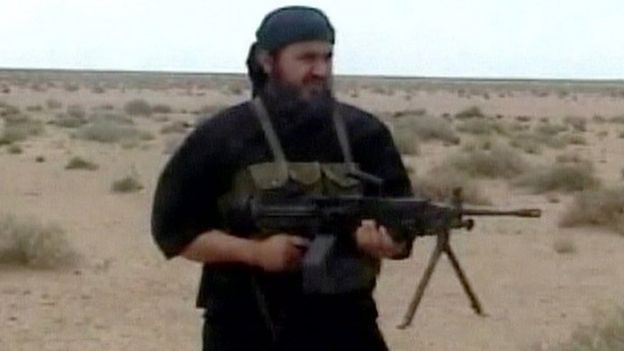 GETTY IMAGES
GETTY IMAGES
After Zarqawi's death in 2006, AQI created an umbrella organisation, Islamic State in Iraq (ISI). ISI was steadily weakened by the US troop surge and the creation of Sahwa (Awakening) councils by Sunni Arab tribesmen who rejected its brutality.
Baghdadi, a former US detainee, became leader in 2010 and began rebuilding ISI's capabilities. By 2013, it was once again carrying out dozens of attacks a month in Iraq.
It had also joined the rebellion against President Bashar al-Assad in Syria, setting up the al-Nusra Front.
In April 2013, Baghdadi announced the merger of his forces in Iraq and Syria and the creation of "Islamic State in Iraq and the Levant" (Isis). The leaders of al-Nusra and al-Qaeda rejected the move, but fighters loyal to Baghdadi split from al-Nusra and helped Isis remain in Syria.
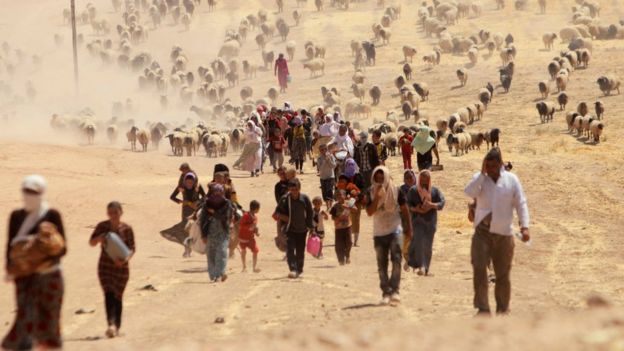 REUTERS
REUTERS
At the end of December 2013, Isis shifted its focus back to Iraq and exploited a political stand-off between the Shia-led government and the minority Sunni Arab community. Aided by tribesmen and former Saddam Hussein loyalists, Isis took control of the central city of Falluja.
In June 2014, Isis overran the northern city of Mosul, and then advanced southwards towards Baghdad, massacring its adversaries and threatening to eradicate the country's many ethnic and religious minorities. At the end of the month, after consolidating its hold over dozens of cities and towns, Isis declared the creation of a caliphate and changed its name to "Islamic State".

How much territory does IS control?
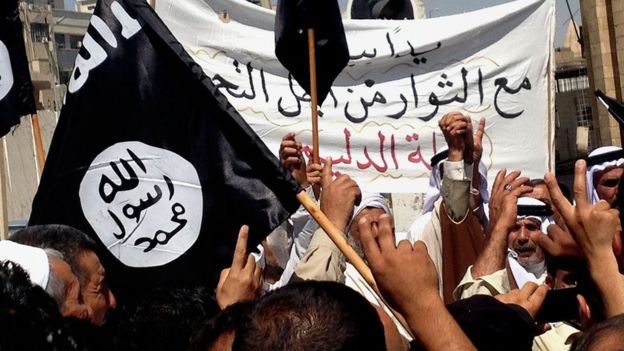 AP
AP
In September 2014, the then director of the US National Counterterrorism Center (NCTC), Matthew Olsen, said IS controlled much of the Tigris-Euphrates river basin - an area similar in size to the United Kingdom, or about 210,000 sq km (81,000 sq miles).
A year later, the US defence department declared that IS frontlines in much of northern and central Iraq and northern Syria had been pushed back significantly by US-led coalition air strikes and ground operations. IS could no longer operate freely in roughly 20-25% of populated areas in Iraq and Syria where it once could, it said.
The defence department estimated that IS had lost approximately 15,000-20,000 sq km (5,790-7,720 sq miles) of territory in Iraq, or about 30-37% of what it controlled in August 2014, and 2,000-4,000 sq km (770-1,540 sq miles) in Syria, or about 5-10%.
Despite this, IS has been able to capture new territory of strategic value over the same period, including the city of Ramadi in Iraq's Anbar province and Palmyra in Syria's Homs province.
Analysts also note that the US figures do not necessarily reflect the situation on the ground. In reality, IS militants exercise complete control over only a small part of that territory, which includes cities and towns, main roads, oil fields and military facilities.
They enjoy freedom of movement in the largely uninhabited areas outside what the Institute for the Study of War calls "control zones", but they would struggle to defend them.
Similarly, it is not entirely clear how many people are living under full or partial IS control across Syria and Iraq. In March 2015, the president of the International Committee of the Red Cross put the figure at more than 10 million.
Inside areas where IS has implemented its strict interpretation of Sharia, women are forced to wear full veils, public beheadings are common and non-Muslims are forced to choose between paying a special tax, converting or death.

How many fighters does it have?
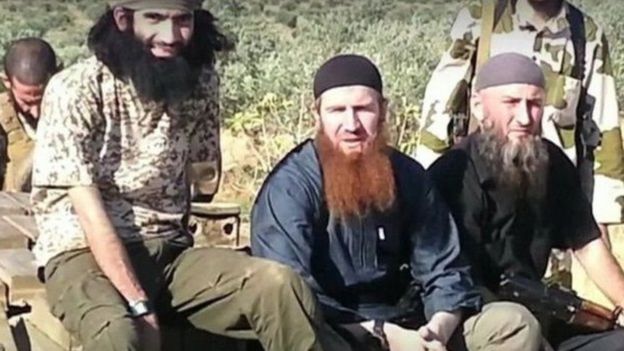 YOUTUBE
YOUTUBE
In February 2015, US Director for National Intelligence James Clapper said IS could muster "somewhere in the range between 20,000 and 32,000 fighters" in Iraq and Syria.
But he noted that there had been "substantial attrition" in its ranks since US-led coalition air strikes began in August 2014. In June 2015, US Deputy Secretary of State Antony Blinken said more than 10,000 IS fighters had been killed.
To help mitigate the manpower losses, IS has turned to conscription in some areas. Iraqi expert Hisham al-Hashimi believes only 30% of the group's fighters are "ideologues", with the remainder joining out of fear or coercion.
A significant number of IS fighters are neither Iraqi nor Syrian. In October 2015, National Counterterrorism Center Director Nicholas Rasmussen told Congressthat the group had attracted more than 28,000 foreign fighters. They included at least 5,000 Westerners, approximately 250 of them Americans, he said.
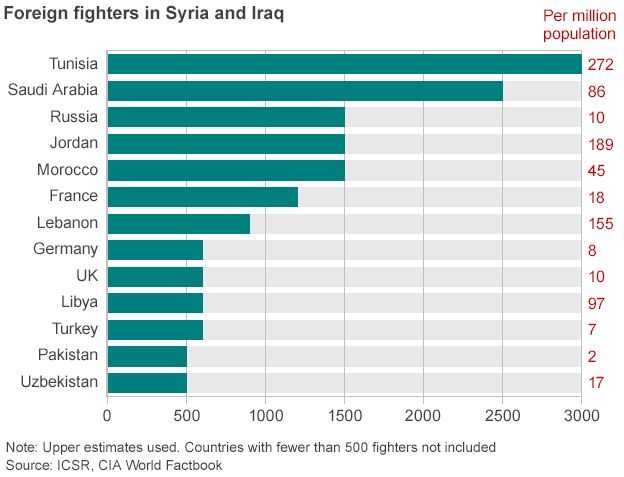
Studies by the London-based International Centre for the Study of Radicalisation and Political Violence (ICSR) and the New York-based Soufan Group suggest that while about a quarter of the foreign fighters are from the West, the majority are from nearby Arab countries, such as Tunisia, Saudi Arabia and Jordan and Morocco.

What about its targets outside Iraq and Syria?
In late 2015, IS began to lay claim to attacks outside its territory. An Egyptian affiliate, Sinai Province, said it downed a Russian passenger plane in the Sinai peninsula, killing all 228 on board. It gave no details, but the UK and US later said it was likely that a bomb caused the crash - whether or not a bomber was linked to IS.
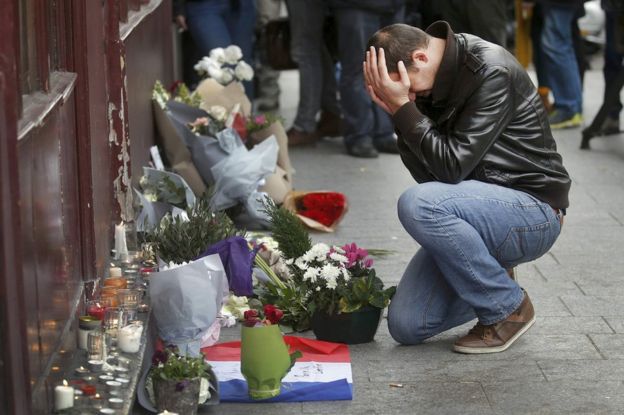 REUTERS
REUTERS
IS also claimed twin blasts in the Lebanese capital Beirut which killed at least 41 people. Militants from the Lebanese movement Hezbollah have been fighting in neighbouring Syria on the side of IS' enemy, Syrian President Bashar al-Assad.
And then on 13 November, at least 128 people were killed in a wave of attacks around Paris. IS said it was behind the violence - French President Francois Hollande described it as "an act of war".

What weapons does IS have?
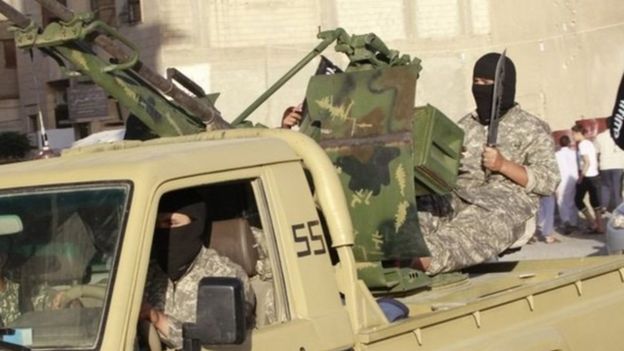 REUTERS
REUTERS
IS fighters have access to, and are capable of using, a wide variety of small arms and heavy weapons, including truck-mounted machine-guns, rocket launchers, anti-aircraft guns and portable surface-to-air missile systems.
They have also captured tanks and armoured vehicles from the Syrian and Iraqi armies. Their haul of vehicles from the Iraqi army includes armoured Humvees and bomb-proof trucks originally manufactured for the US military.
Some have been packed with explosives and used to devastating effect in suicide bomb attacks.
The group is believed to have a flexible supply chain that ensures a constant supply of ammunition and small arms for its fighters. Their considerable firepower helped them overrun Kurdish Peshmerga positions in northern Iraq in August 2014 and the Iraqi army in Ramadi in May 2015.

Where does IS get its money from?
 REUTERS
REUTERS
The militant group is believed to be the world's wealthiest. It initially relied on wealthy private donors and Islamic charities in the Middle East keen to oust Syria's President Assad. Although such funding is still being used to finance the travel of foreign fighters to Syria and Iraq, the group is now largely self-funding.
The US Treasury estimates that in 2014 IS may have earned as much as several million dollars per week, or $100m in total, from the sale of crude oil and refined products to local middlemen, who in turn smuggled them in Turkey and Iran, or sold them to the Syrian government.
But air strikes on oil-related infrastructure are now believed to have diminished such revenue.

Kidnapping also generated at least $20m in ransom payments in 2014, while IS raises several million dollars per month through extorting the millions of people living in areas under its full or partial control, according to the US Treasury.
IS is believed to raise at least several million dollars per month by robbing, looting, and extortion. Payments are extracted from those who pass through, conduct business in, or simply live in IS territory under the auspices or providing services or "protection".
Religious minorities are forced to pay a special tax. IS profits from raiding banks, selling antiquities, and stealing or controlling sales of livestock and crops. Abducted girls and women have meanwhile been sold as sex slaves.

Why are their tactics so brutal?
 AP
AP
IS members are jihadists who adhere to an extreme interpretation of Sunni Islam and consider themselves the only true believers. They hold that the rest of the world is made up of unbelievers who seek to destroy Islam, justifying attacks against other Muslims and non-Muslims alike.
Beheadings, crucifixions and mass shootings have been used to terrorise their enemies. IS members have justified such atrocities by citing the Koran and Hadith, but Muslims have denounced them.
Even al-Qaeda leader Ayman al-Zawahiri, who disavowed IS in February 2014 over its actions in Syria, warned Zarqawi in 2005 that such brutality loses "Muslim hearts and minds".

ไม่มีความคิดเห็น:
แสดงความคิดเห็น